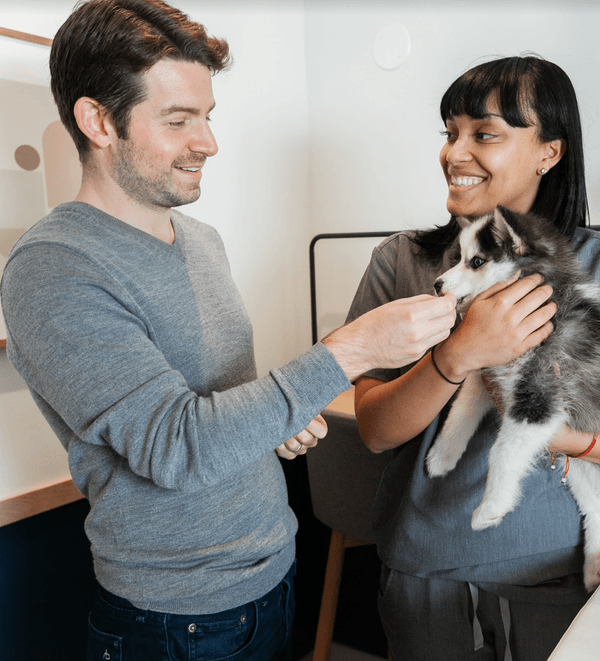
How To Brush Your Dog’s Teeth
Brushing your dog’s teeth is extremely important for keeping their mouth fresh and healthy! Daily brushing can help reduce the risk for dental disease and bad breath, and improve your pup’s overall health.
Why is brushing my dog’s teeth important?
Just like humans, a dog’s oral health affects their overall well-being. By tending to your pet’s teeth, you can help prevent tooth loss, dental disease, gingivitis, and other serious health issues.
Plaque—a thin film on the teeth—accumulates due to food and saliva. This film can be removed by brushing. Left untreated, plaque hardens into tartar, which is much harder to remove.
Tartar accumulation leads to periodontal disease, a condition affecting not only the teeth, but also the structures around them (the gums, periodontal ligament that holds the tooth in place, and even the jaw bone). This can lead to extreme pain and inflammation inside your dog's mouth.
Plus, bacteria in the mouth can enter the bloodstream through inflamed gums, leading to bacterial deposits on the heart or kidneys. In that way, your dog’s mouth affects their whole body.
You can help to remove plaque and prevent periodontal disease by brushing your pup’s teeth on a daily basis.
How to brush your dog’s teeth
It’s important to ease into a tooth brushing routine. Start by getting your pet comfortable with your hands being near their mouth — don’t jump into using a toothbrush right away.
Start with just a treat. Put a bit of natural peanut butter on your index finger and let your pup lick it off. Do this 1-2 times a day for 5 days.
Then, try approaching them when their mouth is closed. Lift their lip and touch your finger to their gums and teeth. Follow this with a treat. Continue for 1-2 weeks. Keep sessions under 2 minutes, and always be gentle.
Next, do the same with pet toothpaste for a few days. Do not use human toothpaste as it can be toxic to pets—instead, use a toothpaste made for dogs and cats.
Once your dog is comfortable with your fingers in their mouth, wrap one finger in medical gauze. Touch it to their teeth and follow with a reward. Repeat once daily at the same time every day for 1-2 weeks.
Now, your pet is ready for a finger toothbrush. Put a small amount of pet toothpaste on it, and brush in small circles. Aim for 30 seconds on each side (but start with just a few seconds at a time until your pet is comfortable). Make sure to reward them verbally and with treats during and after.
After a few sessions, you can graduate to a pet toothbrush. If you need to stick with a finger toothbrush, though, that’s fine, too! Brush the outside of your dog’s teeth, aiming toward the gum line which is where dental disease usually starts.
Brush your dog’s teeth every day, because plaque can develop and start to harden in just 24 hours. Make sure to reward your pet after every session so it remains a positive experience for them.
What type of toothbrush should I use?
There are several types of toothbrushes that can be used to brush your dog's teeth. Some of the most common include a finger brush, pet toothbrush, or even a human toothbrush with soft or extra soft bristles.
What type of toothpaste can I use for my dog?
Human toothpaste should never be used for your pooch. Some of these toothpastes contain xylitol, which is extremely toxic for dogs. Also, human toothpaste was not designed to be swallowed (and dogs don’t know how to rinse and spit!) and comes in flavors that are unpleasant to dogs.
Instead, use a toothpaste specifically designed for dogs! It’s safe to eat, and most dogs enjoy the taste, with flavor options such as chicken.
My dog won’t let me brush their teeth… What should I do?
If you’ve tried all the recommendations for brushing your dog’s teeth and it’s still an unpleasant experience for both of you, there are some other options you can try, such as dental diets and treats, dental toys, and water additives.
There’s no replacement for daily toothbrushing, which veterinary dentists consider to be the “gold star” of home dog dental care. However, these additional options will still provide some benefit.
Dog dental diets, chews, and treats
These options can be combined with toothbrushing for maximum dental benefit!
The best dog dental chews, treats, and diets have the VOHC (Veterinary Oral Health Council) seal of approval right on the packaging.
Just check with your vet that these goodies won’t disrupt your dog’s feeding plan (you may need to reduce some of their regular food to avoid weight gain whenever you add a new treat).
Every dog is an individual with unique health and dental care needs, so your veterinarian may have some additional, personalized recommendations, too.
Be sure to bring your pup in for their regular checkups. That way, your vet can spot any potential dental care problems early, let you know when a dental cleaning at the veterinary practice is needed, and give you tips on how to provide the best home dental care to your furry companion.
Concerned about your dog's oral health? Book a dental consultation.